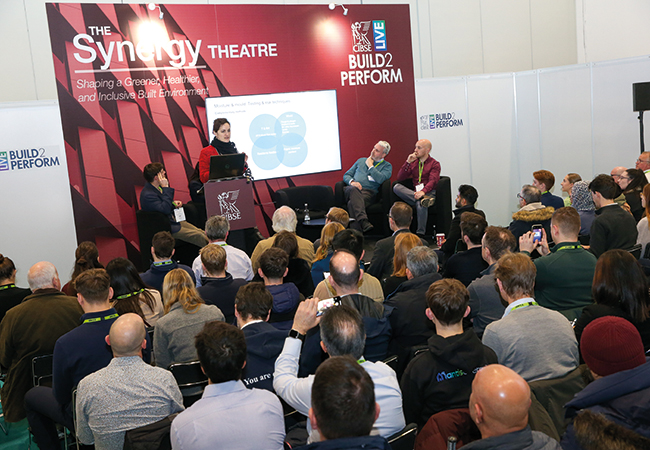
Andrew Moore, head of operations for building control, at the BSR
There was an audible sharp intake of breath when Andrew Moore, head of operations for building control, at the UK’s new Building Safety Regulator (BSR), addressed CIBSE’s recent golden thread building safety conference.
He told delegates that current design and build (D&B) procurement methods for higher-risk buildings (HRBs) in the UK would not be possible under new building safety regulations. ‘Design occurring at the same time as construction will not be viable,’ he said. ‘D&B will have to change.’
The reason for the audience’s collective shock is that this form of procurement makes up 58% of contracts in the UK1.
The golden thread event was held at The Royal Society, London, shortly before major safety regulations came into force on 1 October. Among the changes that Moore says will force the industry to rethink the use of D&B is the requirement for a ‘dutyholder’ to be responsible for overseeing all aspects of building work through a statutory change control process. The dutyholder could be the client, principal contractor, principle designer, or any other designers or contractors.
Regulations applying to Higher-Risk Buildings
By Hywel Davies HonFCIBSE, technical officer at CIBSE
There are three significant sets of regulations placing new duties on accountable persons for HRBs.
The Higher-Risk Buildings (Descriptions and Supplementary Provisions) Regulations 2023 determine which buildings will be subject to the new, more stringent, safety regime for HRBs. They do this by completing the definitions of ‘higher-risk building’ at section 120D of the Building Act 1984 (which is inserted into the 1984 Act by section 31 of the 2022 Act) and in section 65 of the 2022 Act. Following these changes, the 1984 Act now covers design and construction work carried out in respect of an HRB.
The Building Safety (Registration of Higher-Risk Buildings and Review of Decisions) (England) Regulations 2023 set out the detailed requirements to register HRBs with the Building Safety Regulator. Anyone who is an accountable person for an HRB had until the end of September to register the building.
Once a building is registered, accountable persons must provide key building information for it.
The Higher-Risk Buildings (Key Building Information etc.) (England) Regulations 2023 prescribe the information required.
Higher-Risk Buildings (Keeping and Provision of Information etc.) (England) Regulations 2023 make provision for what information and documents the principal accountable person and any other accountable person must keep in relation to that HRB. See bit.ly/CJSafety
Under the new rules for HRBs, any design changes must be documented and managed after the building design has been approved for construction by the BSR, at what is known as Gateway 2. (Gateway 1 is the planning application stage, while Gateway 3 is when the BSR approves the building after construction.) Major changes after Gateway 2 need approval by the BSR before they can be made, which could lead to project delays. Smaller changes deemed ‘notifiable’ can be carried out, but must be flagged with the BSR.
The process doesn’t lend itself to D&B, said Moore: ‘Under the new regime, you have to design it and then build it. D&B for HRBs doesn’t fit in with the methodology.’
David McCullogh, compliance manager at Balfour Beatty, closely studied the Building Safety Act to ensure his company takes the necessary steps to comply with the new regulations. Speaking at the golden thread event, he said he believed D&B procurement for HRBs is possible under the new building safety regime, but that processes would have to change significantly for contractors to comply.
Regulatory impact
Before the new regulations came into force on 1 October, a principal designer working on a D&B contract could incorporate additional design information, and the contractor would update the construction plan submitted to building control as required. There was no need for further statutory approval from building control if changes were made.
In her independent review, Building a safer future, Dame Judith Hackitt noted that there was ‘no over-arching statutory requirements to report or record changes to previously agreed plans, even where they will have a substantial impact on building safety (or wider Building Regulations requirements)’. She said the lack of oversight meant D&B contracts can often result in ‘uncontrolled, undocumented, and poorly designed changes being made to the original design intent’.
Dame Judith added that building control bodies were overly reliant on the need to ensure positive, open and ongoing relationships with contractors (or sophisticated interventions at the completion stage)’. Under the new regime for HRBs, there is no longer the flexibility to make significant changes without having to go back to the BSR for approval.

Balfour Beatty’s David McCullogh
McCullogh said it was clear that the regulatory changes recommended by Dame Judith do not preclude any particular methods of construction. However, they do place an imperative on clients to tighten up processes to ensure a good understanding of how the project is delivered. ‘It was the thoroughness of design finalisation and timing that she commented on, not the concept itself,’ he added.
McCullogh started his presentation by highlighting the advantages of D&B contracts. ‘D&B has become a very attractive method of procurement for clients because it removes the risk of extra costs associated with design errors from the client and places these with the contractor,’ he said, adding that contractors like it because it allows buildability to be incorporated into the design solutions – for example, synchronicity of design with their supply chains.
David Stevens FCIBSE, director of estates, facilities and capital development at East London NHS Foundation Trust, agreed, saying: ‘D&B makes cost and budget control much clearer, a key factor for public sector or higher education clients.’
Making D&B work for HRBs
For D&B procurement to be viable for HRBs under the safety regime change, McCullogh said ‘minimising, if not completely eliminating, change was essential, as formalised change approval would be expensive and entail time implications’.
‘If D&B is to continue to be feasible, all design will need to be done in a timely way, and be much more upfront at Gateway 2,’ he added. ‘It is perfectly permissible in the new regulations to have the Gateway 2 information submitted in a phased way, but it is clear that D&B will have to be done in the way it was intended, and not – as has often happened – with work being carried out without design being completed, never mind approved, often dubbed “build and design”.’
McCullogh explained that contractors will have to assemble a capable team, ensuring that every member is competent and has a good understanding of their individual responsibility. ‘Timely, holistic design approaches should replace isolated, siloed practices,’ he said.

David Stevens, East London NHS Foundation Trust
Construction should be approached in a similar way, especially where compliance is dependent on several mutually dependent trades, such as drylining, service penetrations and firestopping, added McCullogh. ‘Project managers need to shift their focus to manage compliance, not just cost,’ he said.
‘Poor aspects of D&B, where construction may have started prior to finalisation of designs, will no longer occur,’ said Stevens. He believes that the use of two-stage tendering – where a contractor is brought in much earlier – is likely to increase. ‘Under the new act, the design for a new HRB must be complete before construction can commence, but mandatory HRB change control procedures are likely to be lengthy and costly. This means getting it right first time is arguably more achievable with a properly procured and early appointed contractor on board,’ he said.
Because a D&B team works under a single contract with the project owner, Stevens argued that there is the potential for much better management of the golden thread, especially as contractors are ultimately accountable for delivery of the design, construction and handover. ‘The less moving parts, the better,’ he said.
McCullogh warned that the BSR will be much stricter about design being signed off before building occurs. ‘Make sure your design is compliant before you put your spade in the ground. Design, design, design: those are my top three priorities, and it’s really at the heart of this new regime.’




